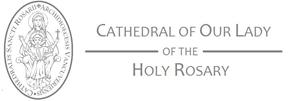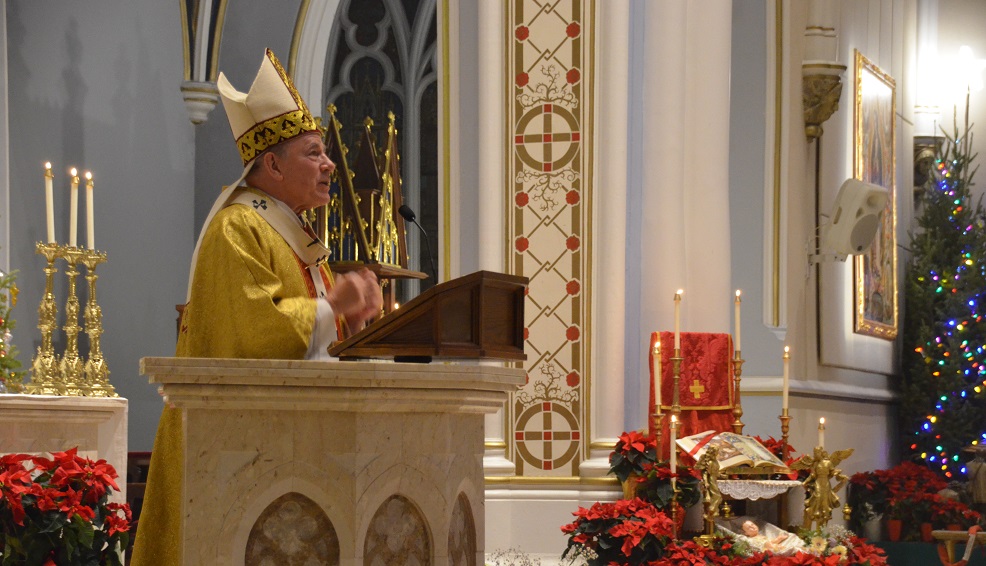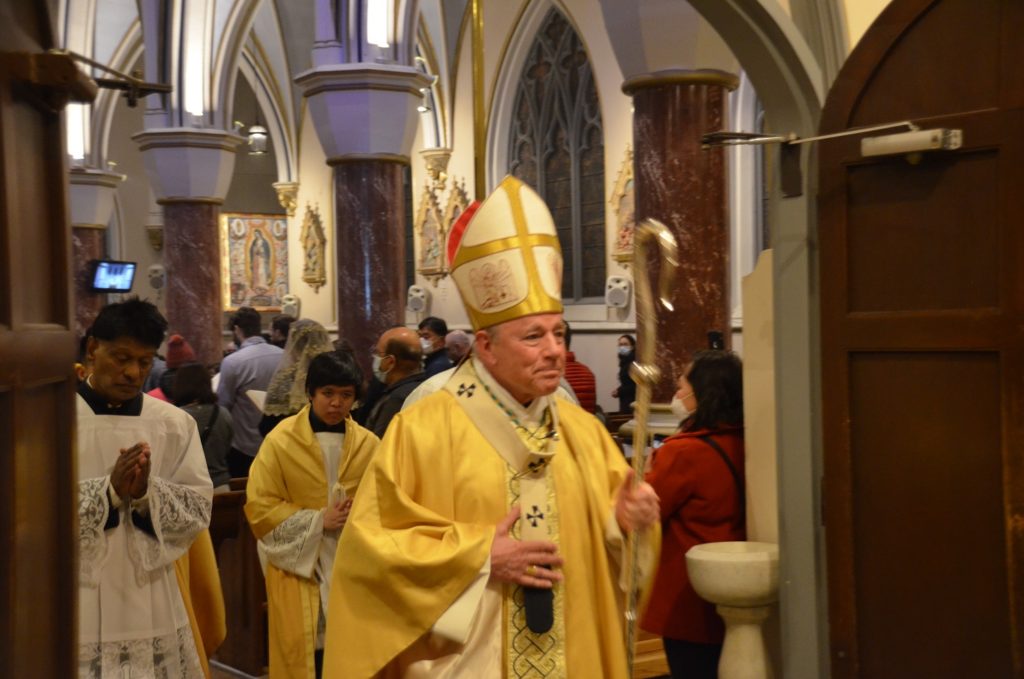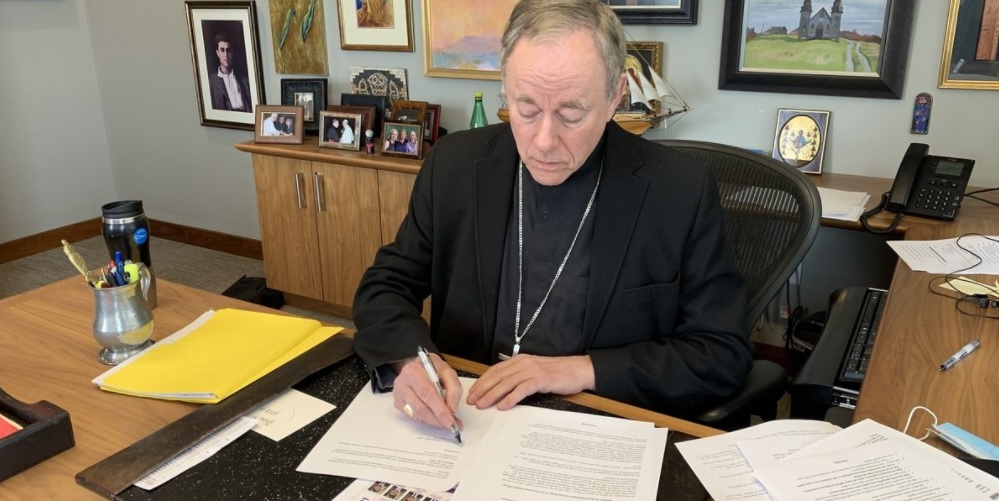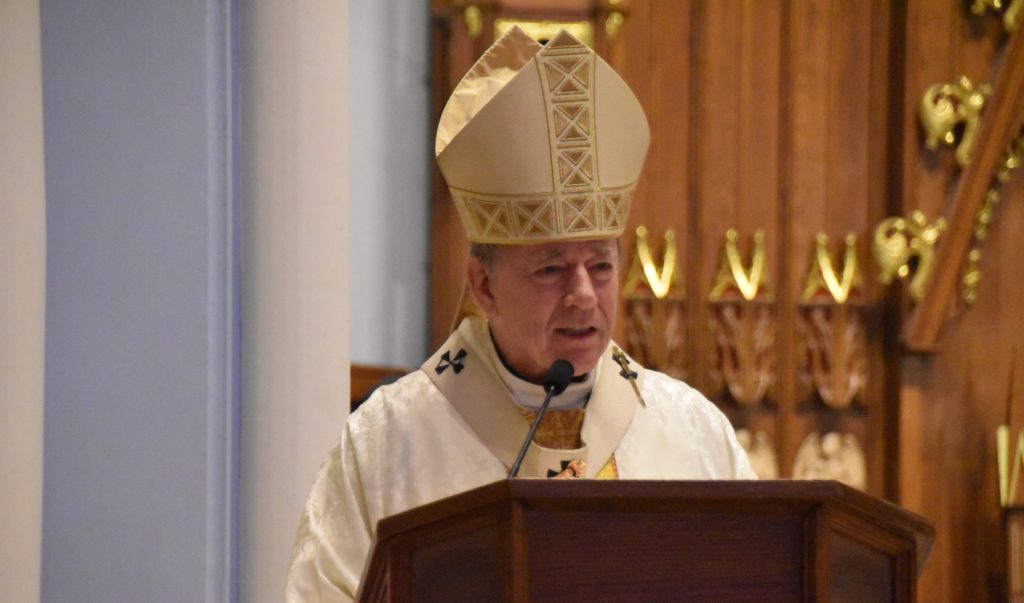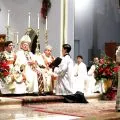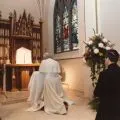Dear brother priests, deacons, and especially tonight, dear friends who are gathered in your homes to celebrate the “good news of great joy for all the people: for to you is born this day in the city of David a Saviour, who is the Christ, the Lord” (Lk 2:11).
Introduction
This is the Christmas of the pandemic, of a health, economic and social crisis that has indiscriminately struck the whole world. It is a reality we are all experiencing, even as we celebrate “this most sacred night radiant with the splendour of the true light,”1 Jesus Christ.
Indeed, the last nine months of the pandemic have been a time of trial, but tonight we can situate this invisible enemy within the broader picture of God’s plan of salvation. I have heard some people say that Christmas is being “cancelled” this year. While many traditional celebrations are prudently curtailed, what is most significant about Christmas can never be “cancelled” or eliminated: the “Child born for us, and the Son given to us” (cf. Is 9:8) on that first Christmas remains forever our Living Hope, Jesus Christ, who is “the same yesterday and today and forever” (Heb 13:8). In the midst even of great losses and suffering, God is still here with us, for he is Emmanuel.
Pausing before the Nativity Scene
Allow me on this silent, holy night to draw your attention to one of the most cherished Christmas traditions, one that, thanks be to God, is completely unaffected by COVID-19. I’m speaking about the Nativity scenes that we put up in the church of our homes, and have been doing so since the tradition first began with St. Francis of Assisi in the thirteenth century. These scenes are a “simple yet eloquent invitation to open our hearts and minds to the mystery of life”2 and to the beauty of God who is in love with his people. They remind us that God has not remained far away and invisible in Heaven, but has come to earth to live with us and die for the forgiveness of our sins. As we heard in the Roman Martyrology proclaimed by Deacon Raffaele, God desired “to consecrate the world by his most loving presence.”
To pause with your family, standing or kneeling before a Nativity scene you have set up in your home, is a beautiful way to celebrate God’s closeness during this pandemic. Such a gesture can rekindle your conviction that God is alive and active in your life, that Jesus is close to you.3
This is the time to invite the Holy Family into your home where there are joys, worries and sorrows. When together as a family, I urge you to place yourselves in the Lord’s hands, to speak to him silently of the people and situations that burden your heart, to take stock with him of this trying year that is drawing to a close, and to share with him your fears, hopes and dreams for the coming year.4
So, let’s now gaze at the principal figures in the Nativity scene. Despite their silence, each one speaks to us about what St. Paul wrote in tonight’s second reading, about how “in the present age” we are “to live lives that are self-controlled, upright and godly” (Tit 2:11).
Mother Mary
First we turn to look at Mary. She leads us to reflect on the great mystery that surrounded her when God knocked on the door of her immaculate heart. Mary responded in complete obedience to the message of the Angel, who asked her to become the Mother of the Messiah. Her words, “Behold, I am the handmaid of the Lord; let it be to me according to your word” (Lk 1:38), tell us that our happiness is found when we abandon ourselves in faith to God’s will.5
In the Nativity scene, we see her humility as she bends low over the manger. With her eyes turned to her newborn Son, Mary was the first to adore the fruit of her womb, Jesus.6 Looking intensely at her Child, she sees in him the very embodiment of God’s love for humanity.7 At her breast, Mary nurtures the Son of God, so that he can become the nourishment of our souls as the Bread of Life (cf. Jn 6).
Let us look upon the Child Jesus with that same love with which Mary saw him.8 May she help us to experience the happiness of Christmas, by treasuring in our hearts the mystery of God who became flesh and dwelt among us (cf. Jn 1:14).9
Guardian Joseph
At Mary’s side in the Nativity scene, protecting her and the Child, stands St. Joseph, a humble yet noble figure. He is the guardian who tirelessly protects his family. Because “there was no place for them in the inn” (Lk 2:7), he found room in a stable where Mary could give birth. Jesus “came into our world in a state of great vulnerability. He needed to be defended, protected, cared for and raised by Joseph.”10 Later, when God warned him of Herod’s threat to the Child, he wisely didn’t hesitate to flee to Egypt (cf. Mt 2:13-15). And once the danger had passed, he brought the family back to Nazareth.
Joseph loved Jesus “with a Father’s heart”.11 He the first teacher of Jesus as a boy and then, as a young man, he taught him his trade. Joseph quietly treasured in his heart the great mystery surrounding Jesus and Mary. As a just man, he entrusted himself always to God’s will, and put it into practice.12
Let us ask Joseph, then, to give us the humility and faith with which he looked upon the Child that Mary had conceived by the Holy Spirit. He preferred to obey God rather than to protect his own reputation.13
The Child Jesus
The tiny Child lying in the hay-filled manger is always the focus of the Nativity scene. To our astonishment, we see Jesus, the Son of God, acting exactly as does every other child. Like them, he sleeps, is nursed by his Mother, cries, and plays. As always, God baffles us. The scene makes us reflect on how our life is part of God’s own life.14
God appears as a Child, for us to take into our arms and into our hearts. Yet, beneath this weakness he conceals his power that creates and transforms all things. It is true: in Jesus, God was a Child, and in this way he wished to reveal the wonder of his love.15
Thus does he reveal the reason for our hope. Jesus is the Child who makes us his children. “Stronger than all our past hurts and failures, or our fears and concerns about the future, there is this great truth: we are beloved sons and daughters.”16 That’s why we don’t have to be overwhelmed by our current situation.
Adoring Shepherds
No Nativity scene is complete without shepherds, who represent the humble and poor who were waiting for the Messiah’s arrival. After Mary and Joseph, they are the first to welcome him because they are among the least of the little ones, and also because they are awake, guarding their flocks at night (cf. Lk 2:8). Both humble and alert.
When they are kneeling before the Child Jesus, the shepherds realize that salvation has finally arrived for them in that newborn “wrapped in swaddling clothes” (Lk 2:12). The shepherds rejoice when they recognize in that Child the sign indicated by the angels.17
For our part, let’s ask the good Lord to grant us the grace of looking upon the Nativity scene with the simplicity of the shepherds, so as to receive the same joy with which they returned home (cf. Lk 2:20).
Conclusion
Dear brothers and sisters: while this year’s celebration of Christmas fills us disciples with joy and hope, it also spurs us on to proclaim God’s presence in our world. Just as Mary offered the Child Jesus to the shepherds, so today the Church offers him to all humanity, so that each person can come to know God’s mercy and love.
When you pause before the Nativity scene in your church of the home, I pray you will see and feel things from the perspective of the figures huddled there. Above all, ask for the grace to repeat to your families, friends and communities what the shepherds heard the Angel declare: “I am bringing you good news of great joy for all the people: for to you is born this day in the city of David a Saviour, who is the Christ, the Lord” (Lk 2:11). Come, come, let us adore him as we continue this celebration of the Eucharist.
✣ J. Michael Miller, CSB
Archbishop of Vancouver
1 Roman Missal, Collect, At the Mass during the Night, p. 163.
2 Benedict XVI, Urbi et Orbi Message (25 December 2008).
3 Cf. Benedict XVI, General Audience (22 December 2010).
4 Cf. Francis, General Audience (18 December 2019).
5 Cf. Admirabile Signum, 7.
6 Cf. Benedict XVI, Urbi et Orbi Message (25 December 2007).
7 Cf. Francis, General Audience (21 December 2016).
8 Benedict XVI, Homily at Midnight Mass (24 December 2006).
9 Cf. Benedict XVI, Urbi et Orbi Message (25 December 2005).
10 Francis, Patris Corde, 5.
11 Francis, Patris Corde, introduction.
12 Cf. Francis, Admirabile Signum, 7.
13 Cf. Benedict XVI, Homily at Midnight Mass (24 December 2006).
14 Cf. Francis, Admirabile Signum, 8.
15 Cf. Francis, Admirabile Signum, 8.
16 Francis, Homily at Midnight Mass (24 December 2020).
17 Cf. Francis, General Audience (21 December 2016).
